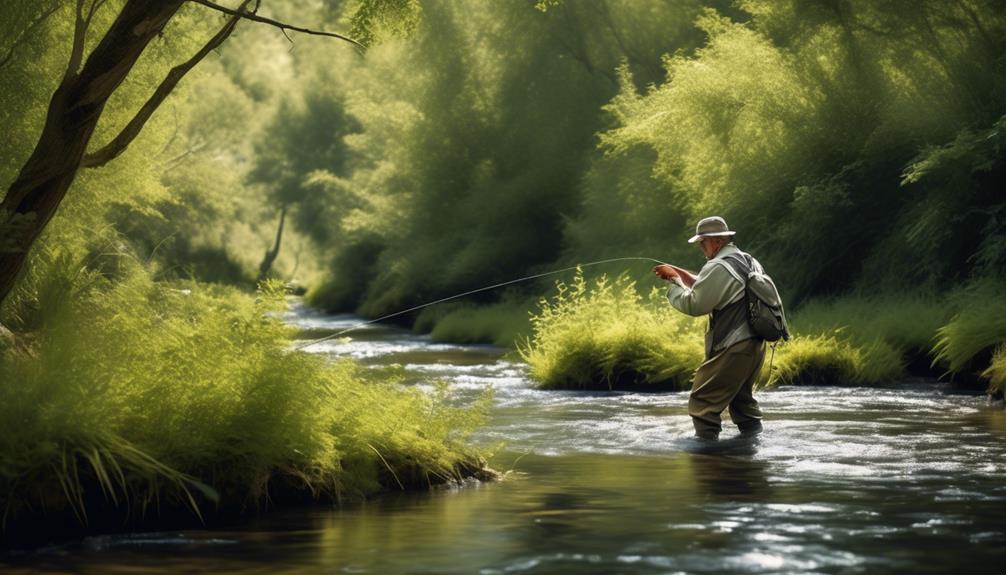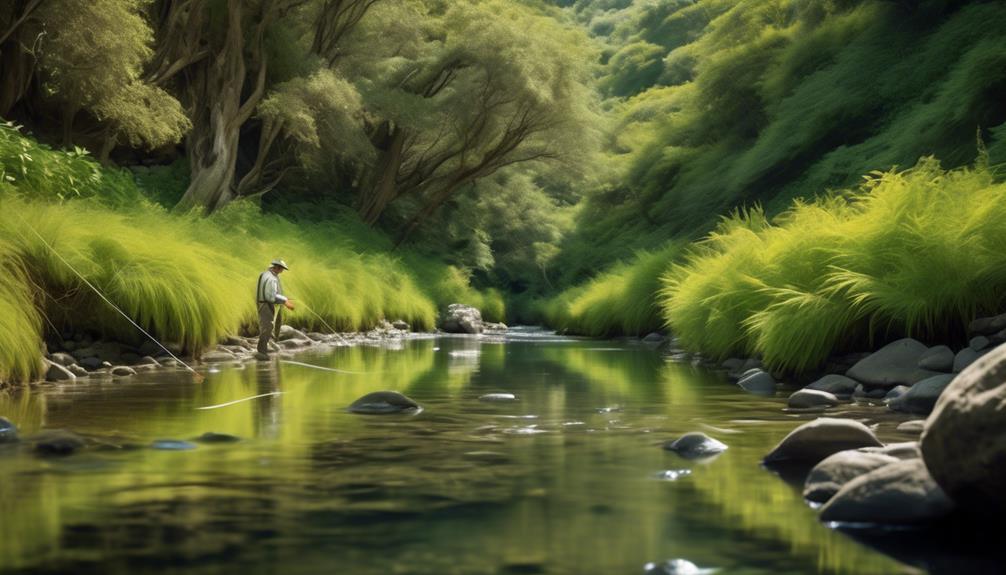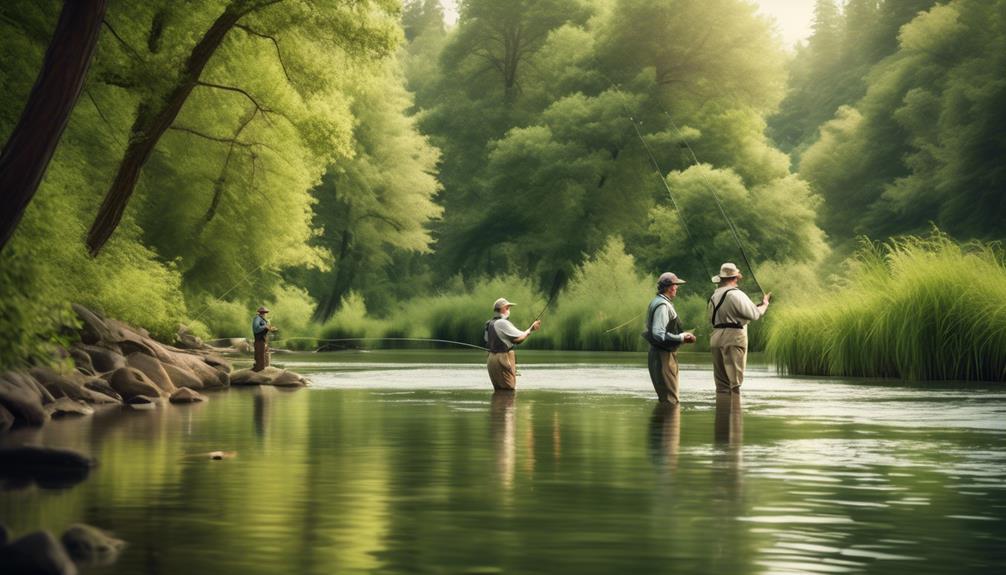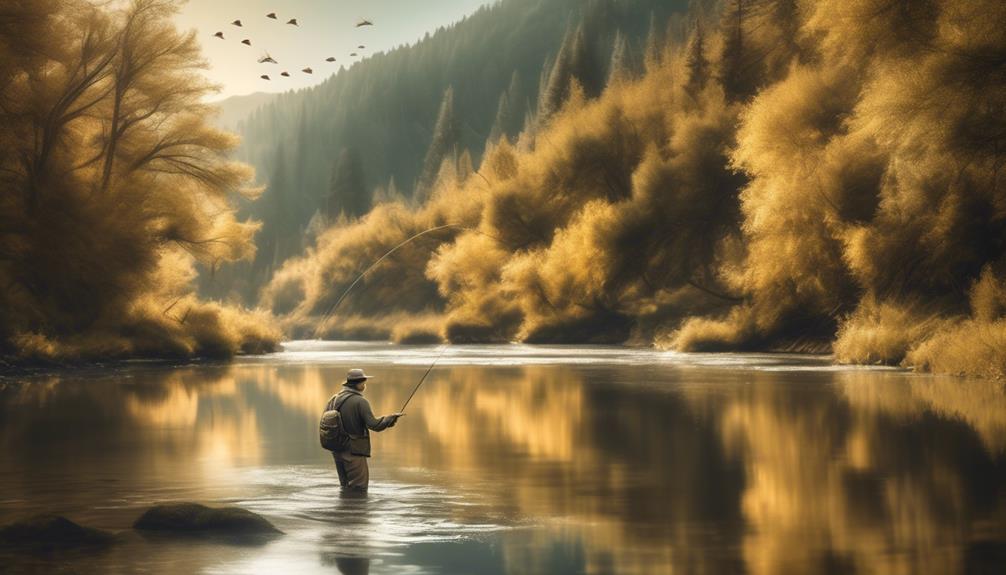Have you ever wondered what sets small stream fly fishing apart from its larger counterparts? The world of small stream fly fishing holds a unique charm that draws anglers in with its intimate and challenging nature.
From the specialized gear and techniques to the delicate presentation required, the small stream experience offers a distinct set of rewards and obstacles. But what exactly makes it so different?
Let's explore the nuances that make small stream fly fishing a fascinating and rewarding pursuit, one that offers a fresh perspective on the sport and the environment in which it takes place.
Small Stream Characteristics
When exploring small stream characteristics, it's crucial to understand how the size and flow of the water impact the behavior of the fish. Small streams offer diverse habitats that attract various fish species. Due to their limited access, these waters often hold pristine environments that support healthy fish populations. The narrow channels and overhanging trees create a unique setting that presents both challenges and opportunities for fly fishing.
In small streams, the diverse habitats, including riffles, runs, and pools, provide ideal conditions for fish to thrive. The limited access to these areas means that the fish aren't as pressured as those in more accessible waters, making them less wary and more receptive to well-presented flies. The narrow channels and overhanging trees create a sheltered environment, resulting in cooler water temperatures and reduced visibility, which can work in your favor as a fly angler.
The presence of overhanging trees also means that small streams often have a rich insect life, which provides an abundant source of food for the fish. This abundance of natural food means that the fish in these waters can be more selective, making presentation and fly choice critical to success.
The unique characteristics of small streams require a different approach compared to larger rivers, but they also offer a rewarding and intimate fly fishing experience.
Adapted Gear and Techniques
Adapting your gear and techniques to the unique characteristics of small streams is essential for maximizing your success in fly fishing these intimate waters. Specialized equipment and modified techniques are crucial for navigating the challenges presented by small streams.
When it comes to gear, consider using a shorter rod, ideally around 7 to 8 feet in length, to allow for better maneuverability in tight spaces. A shorter rod also enables more precise casting, crucial for avoiding overhanging branches and tight spots where larger rods would be cumbersome. In addition, a lighter line weight, typically 3 or 4, is recommended for delicate presentations and to minimize disturbance to the water.
Modified techniques are also essential for small stream fly fishing. An adjusted approach, tailored to the size and layout of the stream, involves using shorter and more accurate casts to navigate the tighter terrain. In addition, mastering the art of roll casting can be invaluable in situations where backcasting space is limited. This technique allows for efficient and accurate presentations without the need for ample space behind you.
Moreover, the ability to read the water and identify where trout are likely to hold in smaller, often more turbulent streams is paramount. By adapting your gear and techniques to the specific demands of small stream fly fishing, you can enhance your effectiveness and truly immerse yourself in the unique and rewarding experience of pursuing trout in these enchanting waters.
Intimate Nature of Small Streams
In small streams, you'll find an intimate connection with nature that allows for a truly immersive fly fishing experience. The close quarters of small streams create an unparalleled sense of closeness to the environment. As you navigate the narrow banks and wade through the shallow waters, you'll feel the natural world enveloping you. The small stream's intimate nature means you can't help but notice every rustle in the bushes, every splash in the water, and every subtle change in the surroundings. This heightened awareness of your surroundings not only enhances the fishing experience but also fosters a deep appreciation for the intricacies of the ecosystem.
Moreover, the intimate nature of small streams also means that they harbor secret spots. These hidden gems may be tucked away in secluded corners or beneath overhanging branches, offering sanctuary to elusive trout and other fish. As you explore these secret spots, you'll feel a sense of discovery and adventure, knowing that these secluded pockets of water hold the promise of a thrilling catch. The intimate size of small streams also means that you'll often have these secret spots all to yourself, creating a sense of exclusivity and solitude that's hard to find in larger bodies of water.
Unique Fish Species
Among the intriguing inhabitants of small streams are unique fish species, adding a captivating dimension to your fly fishing experience. Small streams often harbor native fish species that have evolved in these environments over millennia, offering a sense of connection to the natural history of the area. These native fish, such as brook trout, cutthroat trout, and darters, have adapted to the specific conditions of small streams, making catching them a rewarding challenge.
On the other hand, invasive species can also be found in some small streams, posing a threat to the native fish populations. As an angler, understanding the delicate balance between native and invasive species is crucial for the conservation of these unique fish populations.
Small streams are often considered biodiversity hotspots, supporting a wide array of unique fish species. Due to their secluded nature and limited human disturbance, small streams can provide a sanctuary for rare and endemic fish species. These hotspots are crucial for maintaining healthy fish populations and preserving the genetic diversity of these species. As you venture into these small streams, you become a part of the effort to conserve these unique fish species by practicing responsible catch-and-release techniques and supporting conservation efforts.
Exploring small streams introduces you to the fascinating world of unique fish species, highlighting the importance of preserving these delicate ecosystems. Whether it's encountering native trout or witnessing the diverse array of fish in biodiversity hotspots, small stream fly fishing offers an enriching experience that connects you with the remarkable diversity of aquatic life.
Technical Casting Challenges
Navigating the narrow confines of small streams can present fly fishers with technical casting challenges, requiring precise and delicate maneuvers to avoid obstacles and reach elusive fish. Line control is essential in small stream fly fishing. The ability to mend the line and control its drift is crucial for presenting a fly accurately to wary trout, often in tight spaces with overhanging vegetation and swift currents. Achieving the delicate presentation necessary to entice a strike demands finesse and control, as even the slightest disturbance can spook the fish.
Obstacle navigation is another significant aspect of small stream fly fishing. Whether it's a cluster of rocks, fallen branches, or undercut banks, successful fishing often relies on the angler's skill in maneuvering the line and fly to avoid these obstacles while maintaining accuracy. The angler must be able to make quick, accurate casts to specific spots, sometimes with only a few feet of casting room, all while avoiding snags and maintaining the delicate presentation needed to fool the fish.
In these challenging environments, mastering the technical aspects of casting is essential for small stream success. It requires the angler to adapt and refine their casting techniques, developing the ability to control the line, navigate obstacles, and present the fly with precision. Ultimately, these technical casting challenges add an extra layer of excitement and satisfaction to the pursuit of fish in small streams.
Natural Beauty and Solitude
Mastering the technical aspects of casting is essential for small stream success, but beyond the challenges lies the natural beauty and solitude that awaits those who venture into these tranquil waters.
As you wade through the gentle currents and listen to the soothing sounds of water flowing over rocks, you'll find that small stream fly fishing offers a unique opportunity to connect with nature and experience solitude in a way that larger bodies of water simply can't provide.
Here are four reasons why the natural beauty and solitude of small stream fly fishing are unparalleled:
- Immersive Scenery: Small streams often wind through picturesque landscapes, surrounded by lush forests, vibrant wildflowers, and an abundance of wildlife. The intimacy of these surroundings creates a deep sense of connection with nature.
- Tranquil Environment: The peaceful ambiance of a small stream offers a serene escape from the hustle and bustle of everyday life. It's a place where you can find solitude and a chance to reflect amidst the soothing symphony of nature.
- Intimate Encounters: With fewer anglers frequenting small streams, you're more likely to have these untouched waters all to yourself, fostering a profound sense of solitude and tranquility.
- Unspoiled Wilderness: Small streams often remain unspoiled and untamed, providing a pure and authentic natural experience that allows you to immerse yourself fully in the beauty of the surroundings.
In essence, small stream fly fishing offers an unparalleled opportunity to find solitude and forge a deep connection with the natural world.
Precision and Stealth

To maximize your success in small stream fly fishing, precision and stealth are crucial elements to master. Small streams often present challenging conditions with limited casting space and wary fish. Achieving precision in your casting and movements is essential for a successful fishing experience. When it comes to precision, it's all about finesse. You need to delicately present your fly in tight spots without spooking the fish. This requires a refined touch and the ability to control your line with accuracy.
Stealth is another key component in small stream fly fishing. The ability to approach the water without alerting the fish is a critical part of the strategy. This involves moving quietly along the bank, staying low to avoid being silhouetted, and making careful, deliberate movements. It's all about outsmarting the fish by staying out of sight and making as little disturbance as possible.
Developing a strategic approach to small stream fly fishing involves understanding the layout of the stream, identifying likely holding spots for fish, and planning your approach to each spot with care. This strategic thinking is essential for maximizing your chances of hooking into a fish in these tight quarters.
Environmental Considerations
How can the surrounding environment impact your small stream fly fishing experience? Environmental considerations play a crucial role in shaping your fishing experience. The health of the ecosystem directly affects the quality of the water and the abundance of aquatic life, which are essential for a successful day on the water.
Environmental Considerations for Small Stream Fly Fishing:
- Water Quality: The purity and clarity of the water are paramount for the survival of aquatic species and their food sources. Pollution from agricultural runoff, urban development, or industrial activities can degrade water quality, negatively impacting the fish population and their habitat.
- Ecosystem Health: A well-balanced and thriving ecosystem supports a diverse range of insect life, which in turn sustains healthy fish populations. Understanding the interconnectedness of the ecosystem can guide your approach to conservation and sustainable fishing practices.
- Conservation Efforts: Engaging in conservation efforts, such as participating in stream clean-ups or supporting local habitat restoration projects, can contribute to the preservation of small stream ecosystems. By actively participating in conservation initiatives, you can help maintain the natural beauty and integrity of these environments for future generations of anglers.
- Habitat Restoration: Supporting initiatives aimed at restoring and protecting the natural habitat of small streams can have a lasting impact on the overall health of the ecosystem. Healthy and diverse habitats provide ample opportunities for fish to thrive, ensuring a rewarding fly fishing experience for years to come.
Frequently Asked Questions
What Are Some Common Misconceptions About Small Stream Fly Fishing?
You might think small stream fly fishing is limited, but common misconceptions include it being too difficult or only for experts. In reality, with the right fly patterns, it can be accessible and rewarding for all skill levels.
How Does Small Stream Fly Fishing Differ From Other Types of Fly Fishing?
When you compare small stream fly fishing to other types, you'll notice equipment differences and technique variations. Environmental impact and conservation efforts are also key distinctions, making it a unique and rewarding experience for anglers.
What Are Some Lesser-Known Benefits of Small Stream Fly Fishing?
When you're fly fishing in small streams, you'll discover unique benefits like more flexibility in equipment choices and fishing techniques. Additionally, you'll have a lower environmental impact and more intimate wildlife interactions.
Are There Any Specific Tips for Finding and Accessing Small Streams for Fly Fishing?
When it comes to finding remote, unspoiled streams for fly fishing, your best bet is to research local topographical maps, ask fellow anglers, and explore hidden trails. Once you've found these secluded spots, make sure to respect the environment and practice Leave No Trace principles.
What Are Some Unique Experiences or Encounters That Anglers May Have While Small Stream Fly Fishing?
When small stream fly fishing, you may have unique wildlife encounters like spotting elusive otters or witnessing a majestic eagle swoop down for a catch. The peaceful solitude of these streams enhances the magic of these experiences.
Conclusion
So next time you're looking for a new angling adventure, don't overlook the unique experience of small stream fly fishing.
From the intimate setting to the technical casting challenges, there's something special about these waters that you won't find anywhere else.
Take the time to explore the natural beauty and solitude, and remember to approach with precision and stealth.
With the right gear and techniques, you'll find yourself hooked on the magic of small stream fly fishing.



